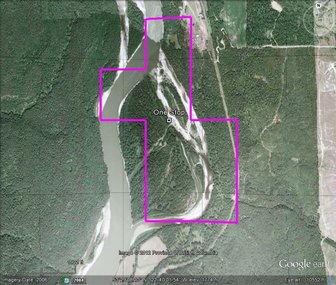One Stop
Location and Licenses
| Central Coordinate 122° 40' 01" W Longitude 53° 29' 15" N Latitude |
| 7 cell tenure – 134.69 hectares (332.68 acres) |
| Price: $ 3,070 plus 5% royalty |
The One Stop placer tenure overlies a northwesterly trending fault and other geological contacts, which may well control the physiology and behavior of this area of the river. The claim is situate along the Fraser River, 5.5 kilometres north of Naver Creek’s confluence with the Fraser, or otherwise, 8.4 kilometres NW of Hickson, within the Cariboo Mining District. During Spring freshet, the higher water level floods the gravel shoal which connects the island to the mainland. During that high water period, the River’s current tends to force materials into the two channels dividing the islands from the mainland, of which islands then serve to reduce the water velocity, creating a natural entrapment. As the water level recedes to its Summer, Fall, Spring levels, this then exposes the two back-channels around the islands, offering easy access to ideal placer ground. The annual rise and fall of the Fraser River refreshes with new deposit.
Access is gained from Highway 97, at co-ordinate 122° 38' 19.37" W Longitude 53° 30 04.12" N Latitude, 9.3 kilometres north of the bridge crossing Hickson Creek. Turning westward onto the secondary roadway, it then leads more or less southward, thence swings due west to pass under the high tension hydro lines, whereafter, one could either travel straight forward or take a narrow roadway striking southward, situate only 240 metres west of the hydro line right-of-way – this route would then swing back around, thence traveling in a northward direction as it weaves in an our of the western boundary of the claim. Gaining access to the actual channel bed, would be down-slope 200 to 200+ metres, depending upon the route chosen. Only limited sampling had been conducted during a 2005 field-sampling program, which in itself did not afford ample opportunity to properly assess the extent and distribution of placer minerals, however, there was significant enough showing for it to be logged for further follow-up.







